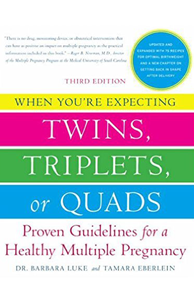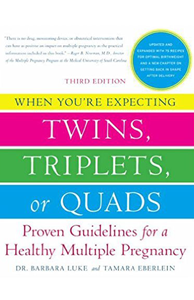A scientific poster from the recent Society for Maternal-Fetal Medicine (SMFM) reveals that optimal maternal nutrition prevents both preterm birth and serious newborn complications. For the past half-century obstetricians have searched for interventions that may reduce the high risk of preterm birth (PTB) and the associated neonatal morbidity and mortality.
Twins represent just over 3% of all live births in the United States, but those babies are responsible for a disproportionate share of all newborn complications. If you walk into any Neonatal Intensive Care Unit (NICU) in the United States more than 10% of all the isolettes will be occupied by babies with the same last name. More than half of all twin births will be preterm (<37 weeks) or low birth weight (<2500g). More significantly, 10-20% will be born < 32 weeks and those are the children who suffer the long term complications or may die. More than 10% of all cases of cerebral palsy in the U.S. occur in a twin.
For the past half century obstetricians have searched unsuccessfully for an effective intervention to reduce this burden of disease. Failed interventions have included hospitalized bedrest which may actually increase the risk of PTB, home uterine activity monitoring to detect early signs of PTL, prophylactic progesterone or other drugs to prevent early labor, acute tocolytic drugs to stop uterine contractions once labor has begun, placing stitches (cerclage) around the cervix to hold the twins inside, and various other hopeful, but ultimately disappointing ideas.
While well-reasoned interventions, all of these failed efforts could be anticipated because they are secondary and tertiary level care interventions. They are efforts to put the genie back in the bottle. Optimal nutrition represents a primary care intervention. The hypothesis is simple. A healthier woman with a larger, more efficient placenta is able to grow a larger, healthier set of twins and is able to keep them in utero longer.
IMHO, one of the most significant studies presented at the recent SMFM annual meeting was presented by Dr. Candice Greenan, biostatistician Barbara Wojciechowski PhD, college and medical students Colleen Christensen and Rosalea Taam, and myself.
We reviewed our experience in caring for 588 twin gestations over a ten year period 2000-2010. During that time we emphasized the importance of achieving BMI-specific weight gain recommendations derived by Luke and colleagues (Journal of Reproductive Medicine, 2003) as the best surrogate we have for optimal nutrition. By the way, the 2009 Institute of Medicine recommendations for weight gain by women carrying twins are based on the previously mentioned Luke study.
Despite our efforts, only 49.3% of the women with twins cared for in our multiples clinic achieved their BMI-specific weight gain goals normalized to their specific gestational age at delivery. We still have a lot of work to do. However, those that did, had a significant 2.5-fold reduction in the rate of PTB < 32 weeks (13% VS 34%). Significant differences were also present for deliveries < 35 and < 37 weeks of gestation. Women who achieved their weight gain goals had significantly larger birthweights (approximately an extra pound per baby) and were significantly less likely to deliver undergrown twins with a birthweight <10th %tile for gestational age.
More significant than an arbitrary gestational age at delivery are the complications associated with early birth. We established a composite of newborn morbidity which included severe respiratory distress syndrome requiring intubation, severe grades of intraventricular hemorrhage, necrotizing enterocolitis requiring bowel resection, bacterial sepsis or neonatal death. Any measure of our composite neonatal morbidity still occurred in 21.4% of the newborns whose mothers achieved their recommended weight gain goals. However, 40.9% of the babies born to mothers who underachieved their weight gain goals experienced serious morbidities.
Correlating with the above numbers, 40.9% of newborns whose mothers failed to achieve their weight gain goals were admitted to the NICU, they spent an average of 12.7 days on the respirator, and had an average hospital length of stay of 22.8 days. These were all significantly worse than for those babies whose mothers did achieve their recommended weight goal: NICU admission rate of 20 .3%, an average of 4.0 days on the respirator and an average hospital length of stay of only 10.6 days.
Many high risk obstetrical consultants lament the absence of any effective interventions to improve outcomes for twin gestations. This is a major frustration, but it isn’t exactly true. Nutrition counseling, nutritional advocacy, ongoing nutritional surveillance are all effective primary care interventions. It is a non-pharmacologic, non-surgical and self-empowering intervention that has been proven successful. It needs to be a major part of every prenatal care visit for women with twins, especially those who are underweight or suffer from other nutritional issues (early nausea and vomiting of pregnancy, anemia, smoker, pica, restricted diets, eating disorders, prior bariatric surgery, etc)
Where do you start? Three simple suggestions- first, add a BMI-specific weight gain chart to each patient’s charts and track each patient’s achievement or non-achievement at each visit. Second, I advise each woman I see with multiples to purchase (I’d give one to each woman if I could) Barbara Luke’s book entitled When You’re Expecting Twins, Triplets or Quads. She is a PhD Nutritionist and Public Health expert and her book covers all aspects of multiple pregnancy care, but focuses primarily on the value of nutrition and how to measure success. It is written for the lay public and includes dozens of great meal recipes. Third, identify an interested and engaged nutritionist who shares the importance of these goals and refer each mother of multiples for a consultation and continuing interaction.
You will know that you are making progress when both you and your patient can predict the results of their fetal growth ultrasounds based on the review of their weight gain charts.
Go Broncos. I hope it’s a great game and Denver comes out on top.







